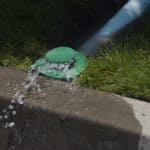TDS Drainage Glossary
Perforated Grates
Although the most popular grates have a slotted pattern, perforated grates are the second most popular grate pattern. Perforated patterns generally consist of a simple hole that is pierced, drilled, or molded into the grate. This pattern offers heel-proof, ADA-compliant, and decorative grate options. Keep in mind that although perforated grates help to keep debris out of trench drains, it is important to ensure that lawn debris doesn’t obstruct flow.
Pipe Outlet
The outlet is the point in the drainage system where the water exits. Outlets are generally located on the side of the drainage channel, through an opening in the bottom of the channel, or through an open-end cap. Some systems offer special adapters that connect to pipes while others have embossed/knockouts that accommodate them. Should the system not offer an adapter, you may have the option to core drill an opening to accept the pipe. Should you need assistance planning your project, call us at 610-882-3630 or request information here. We’re happy to help!
Point Drain
Point drains typically refer to shower or floor drains in bathrooms. Commonly seen in public restrooms with a round grate that fits over a Schedule 40. However, in the drainage industry, it can also be in reference to the lowest point where water gathers. In these areas, drainage can be achieved with the pipe and grate combination mentioned or with catch basins.
Point Weight
Point weight is another way of stating standing or stationary weight. When determining which trench drain system is right for a project, the first consideration should be the weight of the traffic that the trench drains will endure. Typically, Load Class ratings often help to determine the type of grate and drainage system that is needed. However, it is important to consider heavy-duty options when the drains will need to be sustainable for long periods of holding massive weights, such as a horse standing in a wash bay. Normally, grates are designed to withstand rolling vehicles that have weight distribution, not stationary weight.
Pop Up Emitter
Pop-up emitters capture water that flows from a drainage system to a Schedule 40 pipe. The emitter sits on the end of the pipe and sits flush or level with the surface it is installed on. When heavy rainfall occurs, the runoff pushes the ‘lid’ of the emitter up to redirect water to a preferred location. They are typically installed in yards near the curb to channel the rainfall. In some instances, pop-up emitters are installed perpendicular to the curb for rainfall to flow directly into the street side of the yard.

Pour in Place
Poured-in-place concrete trench drains are available in two options. Frame and grate systems that require a contractor to build the trench form that usually consists of a wood structure. Trench forming systems use frame grates and a disposable pre-sloped form used to mold the concrete to form the drain channel. Frame and grate systems can be made of a variety of materials including fiberglass. They provide a DIY trench drain system that allows flexibility in the width, depth, and slope of the channels. Click here to view install instructions for a fiberglass frame and grate system.
Presloped
Trench drain systems are either straight/neutral or pre-sloped. There are several configurations that can be used to achieve a slope. Some systems offer channels that have built-in slopes to quickly divert runoff. Straight channels can be used to create either a non-sloped run or a cascade slope by using channels that are consecutively deeper and connecting them with special couplers to create a step-down effect. A mixed slope is a combination of sloped and straight channels for a smoother step-down effect. Need help planning your next project? Call our experts at 610-638-1221 or request info today.

Pultruded Fiberglass
Pultrusion is a forming process for converting reinforced fibers and resin into fiber-reinforced plastic, also known as fiber-reinforced polymer (FRP). FRP is up to 70% lighter than steel with an exceptional strength-to-weight ratio. FRP is corrosion-resistant, non-conductive, and requires less maintenance. Fiberglass grating is available individually, in frame and grate kits, or in custom sizes. Click here if you are interested in a custom quote.
